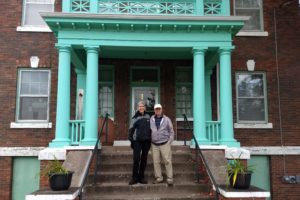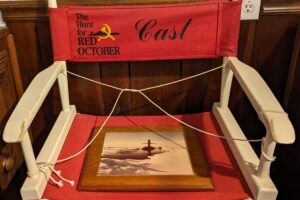After walking around the outside the USS Laffey and learning about its history during WWII, let’s go inside to see where the 336 men lived when they weren’t on deck fighting. Also in this post, we’ll see the “nerve center” of the ship–the CIC–and then we’ll learn about the early helicopter drones used by the Navy.


This generator had a GM 3-cylinder diesel engine coupled to a 100 KW generator. Laffey had 2 of these generators: one forward and one aft. They served as a secondary backup electrical source if the ship’s main turbo generators (steam powered) in the forward and aft engine rooms were out of service.



Remember the old way of artificially bringing life back to someone who’s been hurt?


Steam turbines must operate in a relatively high RPM for best efficiency, while propellers function better in a low RPM range.


Fresh water was needed for boilers and crew usage. Since priority was the boilers, often crew members had to forget about taking showers.

The exhibit in this room was for veterans who served on the Hobson and the Laffey.


internal passageways
Before WWII, a destroyer sailor walking the length of the ship would at some point end up outside. In rough seas, this could be dangerous. Sailors were lost attempting to reach their duty station by being washed overboard. So what did the Navy do? Read on.

This class of destroyers were also the first small warships to use a Combat Information Center (CIC) that we’ll see soon.



where all the work is done

The seamen in this shop were responsible for maintaining and repairing the radars, satellite navigation , and other radio communication systems, including the remote-control radio system used to guide and direct the DASH drone (more about the DASH drone later in this post since the destroyer was used during the Korean, Vietnam, and Cold Wars).


On most destroyers, a Hospital Corpsman took care of those on the ship. He provided basic and emergency healthcare to crew-members, including inoculations, scheduling medical or dental appointments, health inspections, and monitoring of crew’s health conditions.












This electro-mechanical analog computer could calculate and transmit orders for aiming the 5″ guns. Located deep within the ship’s hull to provide protection from battle damage also meant that it had less interference from the ship’s motion.






The quartermaster’s duty was to maintain the course that the captain wanted, and he did so in this chart room.



This room was the unnoticed eye of the ship because the sailors on duty here could be the first ones to detect enemy aircraft and ships. They then transmitted the information through this compartment.


The voice of the ship was within this compartment. It housed such equipment as sophisticated crypto-graph and a high speed teletype, as well as a common Morse code key pad.

CIC
The Combat Information Center was the nerve center of the ship. Per Wikipedia, “A combat information center or action information center is a room in a warship or AWACS aircraft that functions as a tactical center and provides processed information for command and control of the near battlespace or area of operations.”
“The United States developed their Command Information Center concept during the winter of 1942–1943 and implemented it in a surge of refitting and retraining during 1943 after post-battle action analyses of naval battles in 1942.”


The CIC was dark on older ships, primarily because many of the radar screens etc were made of materials that were hard to see in daylight. The walls were painted in dark colors, and the light was red and dimmed.






the DASH
We almost walked by this exhibit after leaving the CIC but are so glad we walked inside to see it.

According to the Imperial War Museum, “The first pilotless vehicles were developed in Britain and the USA during the First World War. Britain’s Aerial Target, a small radio-controlled aircraft, was first tested in March 1917 while the American aerial torpedo known as the Kettering Bug first flew in October 1918.”
1950s-1960s
In the mid-1950s, the Russian Submarine force was becoming larger and more capable. The US Navy wanted a method to counter that threat before any submarine could come within striking distance of one of our ships.
The Navy was developing a rocket-launched anti-submarine torpedo, but it was too limited in range to take advantage of increased detection ranges that the large sonar system provided; plus it was expensive and complex. Each ship would have to be reconfigured to install the system. Naval aviators weren’t receptive either to the idea of launching manned helicopters from small destroyer decks at high sea states. The Navy needed a solution to fighting anti-submarine warfare missions.
By 1956, The Gyrodyne Company on Long Island had been flying and perfecting their coaxial helicopter designs for over 10 years. Their system used 2 rotors of opposite pitch mounted on the same mast assembly that turned in opposite directions. This system eliminated the instability associated with torque, and its power reduced the need and mechanical complexity of a tail rotor.
In 1954, the company had a flight demonstration for the US Marine Corp of 5 of its units. The Navy then asked Gyrodyne if such a vehicle could be used to provide a cheap method of delivering conventional and nuclear anti-submarine weapons at a range from surface ships several orders of magnitude greater than other current systems capabilities.
In April 1958, the Navy awarded Gyrodyne a contract to make minimum modifications to the unit shown in the following picture to investigate the use to not only deliver the specified weapons, but also as an unmanned drone–being able to be launched from a destroyer in any sea state up to level 6 (13- to 20-foot swells), at any time of day and in any type of weather that would normally keep a manned helicopter on deck.

The Drone Anti-Submarine Helicopter (DASH) concept was realized. More “firsts” happened, and on July 1, 1960, it made the first shipboard landing aboard a frigate.
In June 1963, DASH received its approval of large scale production after President John F. Kennedy watched a demonstration from shipboard during a Navy firepower demonstration off the West Coast.


This control unit was eventually used for the DASH that was on the flight deck. Crew members used the controller to launch and recover the drone. Once it was at altitude and on course, control of the drone was transferred to the CIC control unit where radar could be used to direct the drone to the target and release weapons.


Here are the characteristics and standard performance based on 300 HP:
- weight empty – 1035 lbs, normal gross – 2330 lbs
- load fuel, oil – 375 lbs, payload normal – 920 lbs
- speed – up to 80 knots
- endurance – 1.73 hours at 55 knots at sea level
- ceiling – service 16,000 feet, hover 6500 feet
- rate of climb – forward fit 1880 feet minimum, vertical 1180 feet minimum

In 1961, two years after the DASH program first got under way, Gyrodyne started a crew training program to teach Drone Controllers how to fly the aircraft.


Want to know what a destroyer looked like with the DASH system onboard? WWII-era destroyers were reconfigured to have a flight deck and hangar for the DASH so the destroyers could continue to have a useful life. The following picture shows DASH returning from an anti-submarine warfare mission to its home destroyer, the USS Hugh Purvis, which was decommissioned in June 1972 before being sold to Turkey the next month.

changes happening
But the Vietnam war was a different kind of war from what the Navy had been facing. No longer were torpedoes going after submarines in the ocean. As the type of fighting changed, the need for anti-submarine drones decreased.
The DASH was originally designed to drop nuclear-depth bombs or torpedoes and not survive the resulting blast. Off-the-shelf components were used whenever possible to minimize costs since originally the DASH wouldn’t be returning to the ship. This use of the drone resulted in the aircraft’s inability to be used in any other application the way it was configured. Was this the end of the DASH program?

The research arm of the DoD, the Advanced Research Project Agency (ARPA), saw an opportunity to effectively use the existing machines still on destroyers.
While Secretary of Defense McNamara was downplaying the reliability of DASH to Congress in January 1967, he neglected to tell them that he had authorized the Navy to expand the drone’s mission to that of flying surveillance missions into Vietnam.
Two years earlier, with the help of DARPA, the Navy started flying secret “SNOOPY” missions from selected destroyers. Real-time video and film cameras were added for reconnaissance and surveillance. A telemetry system was also added so remote pilots could monitor their actions while on the aircraft and a transponder was added for radar tracking of the drone. These modifications allowed for real-time intelligence gathering for gun spotting of critical targets (such as bridges and resupply-by-ship barges) for waiting off-shore warships.
These drones flew in hostile environments where manned aircraft wouldn’t dare go. Success of SNOOPY was judged by American lives saved. SNOOPY continued flying until the end of 1970. Meanwhile, DARPA and the Navy were working on a program called “Nite Gazelle.” They integrated a multitude of weapons using the DASH airframe so the aircraft could fight back when fired upon. The previous picture from 1972 shows 2 helicopters: one has a 3 bombs installed and the other has a mini-gun and target video camera.
Next came the “Nite Panther” (picture following) that used a unique coaxial, unmanned helicopter for night reconnaissance and smoke screening.
Remaining helicopters were transferred to Naval Air Station China Lake and US Army at White Sands Missile Range for use as target drones to test and improve the next generation of anti-aircraft missiles and air defense systems.
The helicopters continue to fly everyday on “no-kill-missions,” which means it isn’t intentionally shot down. Instead it acts as a target radar/IR emulator testing missile guidance and ground-based attack equipment capabilities so future American fighting forces can get the best equipment possible.

The FAA issued the first commercial drone permits in 2006 after they recognized the potential of non-military and non-consumer drone applications. Now drones are used everywhere for so many different purposes, and now we know how it all got started.




